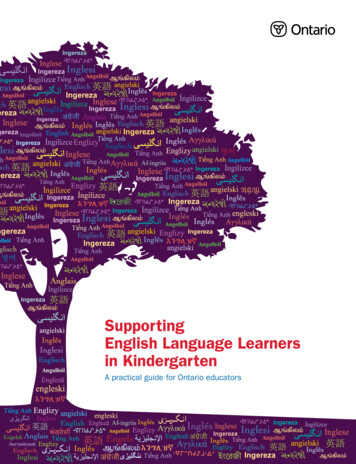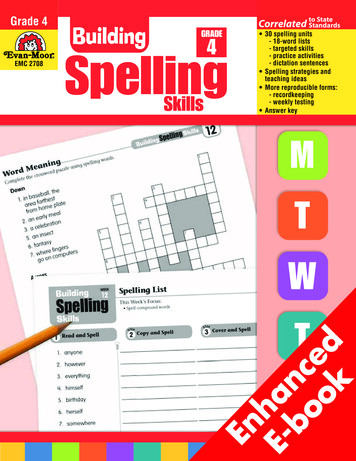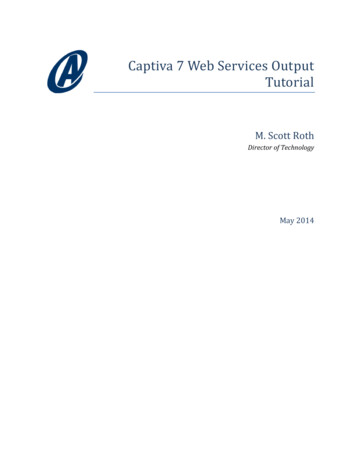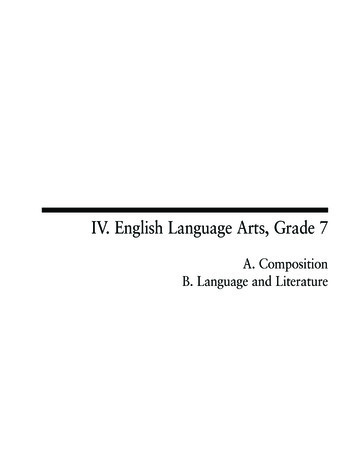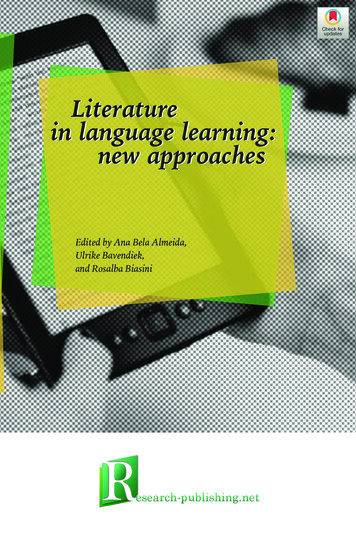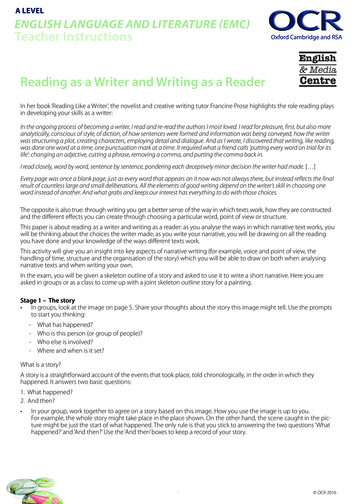
Transcription
A LEVELENGLISH LANGUAGE AND LITERATURE (EMC)Teacher InstructionsReading as a Writer and Writing as a ReaderIn her book ‘Reading Like a Writer’, the novelist and creative writing tutor Francine Prose highlights the role reading playsin developing your skills as a writer:In the ongoing process of becoming a writer, I read and re- read the authors I most loved. I read for pleasure, first, but also moreanalytically, conscious of style, of diction, of how sentences were formed and information was being conveyed, how the writerwas structuring a plot, creating characters, employing detail and dialogue. And as I wrote, I discovered that writing, like reading,was done one word at a time, one punctuation mark at a time. It required what a friend calls ‘putting every word on trial for itslife’: changing an adjective, cutting a phrase, removing a comma, and putting the comma back in.I read closely, word by word, sentence by sentence, pondering each deceptively minor decision the writer had made. [ ]Every page was once a blank page, just as every word that appears on it now was not always there, but instead reflects the finalresult of countless large and small deliberations. All the elements of good writing depend on the writer’s skill in choosing oneword instead of another. And what grabs and keeps our interest has everything to do with those choices.The opposite is also true: through writing you get a better sense of the way in which texts work, how they are constructedand the different effects you can create through choosing a particular word, point of view or structure.This paper is about reading as a writer and writing as a reader: as you analyse the ways in which narrative text works, youwill be thinking about the choices the writer made; as you write your narrative, you will be drawing on all the readingyou have done and your knowledge of the ways different texts work.This activity will give you an insight into key aspects of narrative writing (for example, voice and point of view, thehandling of time, structure and the organisation of the story) which you will be able to draw on both when analysingnarrative texts and when writing your own.In the exam, you will be given a skeleton outline of a story and asked to use it to write a short narrative. Here you areasked in groups or as a class to come up with a joint skeleton outline story for a painting.Stage 1 – The story In groups, look at the image on page 5. Share your thoughts about the story this image might tell. Use the promptsto start you thinking:-----What has happened?Who is this person (or group of people)?Who else is involved?Where and when is it set?What is a story?A story is a straightforward account of the events that took place, told chronologically, in the order in which theyhappened. It answers two basic questions:1. What happened?2. And then? In your group, work together to agree on a story based on this image. How you use the image is up to you.For example, the whole story might take place in the place shown. On the other hand, the scene caught in the picture might be just the start of what happened. The only rule is that you stick to answering the two questions ‘Whathappened?’ and ‘And then?’ Use the ‘And then’ boxes to keep a record of your story.1 OCR 2016
A LEVELENGLISH LANGUAGE AND LITERATURE (EMC)Teacher InstructionsStage 2 – Thinking about the how and whyWhen you answer the questions how did something happen and why did it happen, things start to get more complicated– and more interesting. And this develops the plot of your story. In your group, try answering the how and why questions for your story. Annotate your story boxes with your ideas.Stage 3 – Ways of tellingWriters can choose to tell their stories in any way they want. They make decisions not only about what happens,how and why it happens, but also about how it is told.Narrative is Narrative can be summed up as the way in which the story is told. It involves everything from decisions about theform (drama, film, novel, poem) and genre (romance, thriller, contemporary manners) to decisions about structure,narrative voice and point of view. Working on your own, turn your group story of the painting into a short narrative, making decisions about theway in which you will tell this story.In your group, take it in turns to read aloud your different versions of the story. Talk about the decisions youeach made, for example:------ What was the effect of your different decisions?Go back to your own and experiment with two or three different ways of telling.Here are some of the experiments you could try:----- the type or genre of storythe point of view the events are seen fromwho tells the story (a narrator, a character, different characters)the order of the eventsthe style (description, narration or dialogue? Chatty and conversational, or more formal? Long, complicatedsentences or short simple ones?).If you started at the beginning of your story, start in the middle of the action, or write at the end.Take out all the adjectives.Tell the story using the style of a particular genre (for example, crime or romance).Change the point of view and voice (so if your story is in the third person told by a narrator, try telling it in the firstperson from the point of view of one of the characters).With a partner, read your different experiments and talk about which seem most interesting or engaging. Whichversion would your partner most like to continue reading? Which one would you most like to continue writing?2 OCR 2016
A LEVELENGLISH LANGUAGE AND LITERATURE (EMC)Learner ActivityWhat happened?What happened next?And then?And then?3 OCR 2016
A LEVELENGLISH LANGUAGE AND LITERATURE (EMC)Learner ActivityAnd then?And then?And then?And then?4 OCR 2016
A LEVELENGLISH LANGUAGE AND LITERATURE (EMC)Learner ActivityWe’d like to know your view on the resources we produce. By clicking on the ‘Like’ or ‘Dislike’ button you can help us toensure that our resources work for you. When the email template pops up please add additional comments if you wishand then just click ‘Send’. Thank you.If you do not currently offer this OCR qualification but would like to do so, please complete the Expression of Interest Formwhich can be found here: www.ocr.org.uk/expression-of-interestOCR Resources: the small printOCR’s resources are provided to support the teaching of OCR specifications, but in no way constitute an endorsed teaching method that is required by the Board and the decision to use them lies with theindividual teacher. Whilst every effort is made to ensure the accuracy of the content, OCR cannot be held responsible for any errors or omissions within these resources. We update our resources on a regular basis,so please check the OCR website to ensure you have the most up to date version. OCR 2015 - This resource may be freely copied and distributed, as long as the OCR logo and this message remain intact and OCR is acknowledged as the originator of this work.OCR acknowledges the use of the following content: Reading Like a Writer: A Guide for People Who Love Books and for Those Who Want to Write Them [Paperback] Francine Prose, published 2006 (Excerpts frompages 3, 16) published by Harper Collins, The Death of Chatterton by Henry Wallis; Alamy Limited,5 OCR 2016
In her book ‘Reading Like a Writer’, the novelist and creative writing tutor Francine Prose highlights the role reading plays in developing your skills as a writer: In the ongoing process of becoming a writer




